Gigabyte GA-Z77X-UD5H Review: Functionality meets Competitive Pricing
by Ian Cutress on July 25, 2012 5:00 AM EST- Posted in
- Motherboards
- Gigabyte
- Z77
Multi-GPU Setups
The Gigabyte Z77X-UD5H is the first Z77 motherboard we have tested that uses a full PCIe 3.0 tri-GPU setup, such that we have:
One GPU: x16
Two GPUs: x8/x8
Three GPUs: x8/x4/x4
Our other comparison points use four PCIe 2.0 lanes from the chipset. These setups suffer from limited bandwidth on the third GPU, as well as additional latency as data must transfer through the chipset. These motherboards have a setup such that:
One GPU: x16
Two GPUs: x8/x8
Three GPUs x8/x8/PCIe 2.0 x4
In our testing, we show that the first method of PCIe layout performs a lot better in tri-GPU setups. Note that the downside of this is that if a Z77 motherboard is paired with a non PCIe 3.0 CPU (such as Sandy Bridge), then the final PCIe slot on the board is not functional.
Civilization V
Civilization V is a strategy video game that utilizes a significant number of the latest GPU features and software advances. Using the in-game benchmark, we run Civilization V at 2560x1440 with full graphical settings, similar to Ryan in his GPU testing functionality. Results reported by the benchmark are the total number of frames in sixty seconds, which we normalize to frames per second.
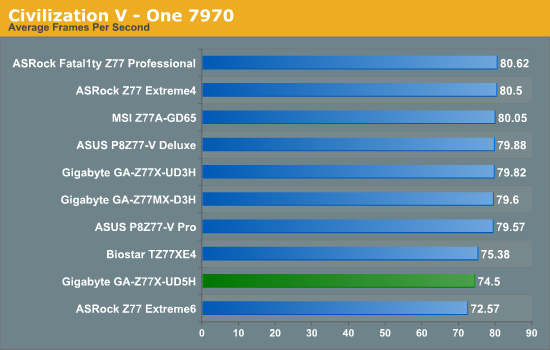

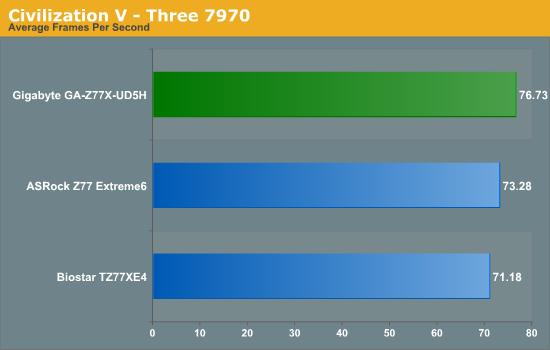
While the UD5H does not perform the best in single and dual AMD cards in Civilization V, it does take the top spot against our tri-AMD setup.
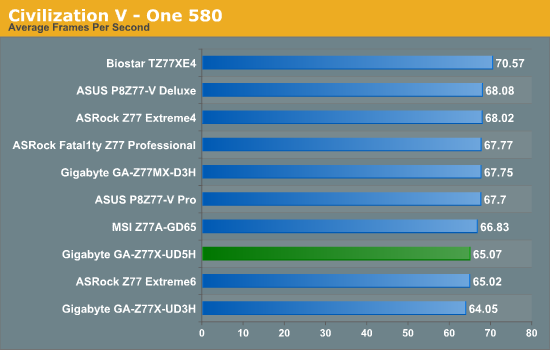

For whatever reason our single NVIDIA test does not perform that well, but the dual NVIDIA GPU test comes near the top.
Dirt 3
Dirt 3 is a rallying video game and the third in the Dirt series of the Colin McRae Rally series, developed and published by Codemasters. Using the in game benchmark, Dirt 3 is run at 2560x1440 with full graphical settings. Results are reported as the average frame rate across four runs.
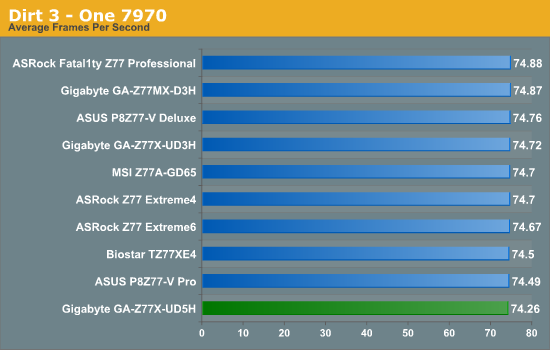
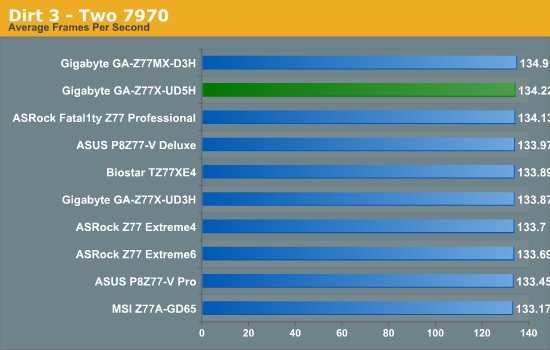
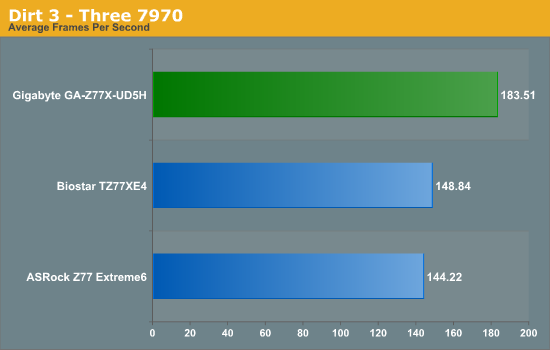
While in the single AMD Dirt3 test the Z77X-UD5H comes bottom, all the results are within statistical variance. In comparison, in the dual AMD Dirt3 test the Z77X-UD5H comes near the top. In our tri-GPU test, the full PCIe 3.0 x4 of the Z77X-UD5H shows its worth with an extra 35-40 FPS over our other motherboards tested.

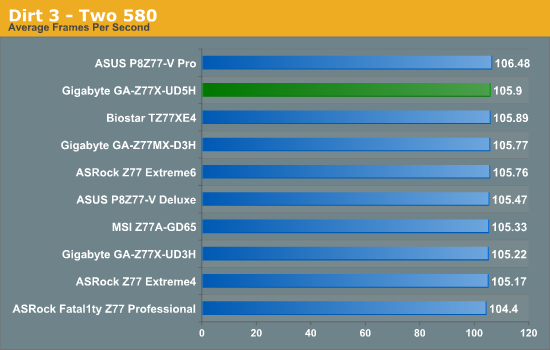
In both our Dirt3 NVIDIA tests, the Z77X-UD5H performs well but within statistical variance of every other board tested.
Metro2033
Metro2033 is a DX11 benchmark that challenges every system that tries to run it at any high-end settings. Developed by 4A Games and released in March 2010, we use the inbuilt DirectX 11 Frontline benchmark to test the hardware at 2560x1440 with full graphical settings. Results are given as the average frame rate from 10 runs.
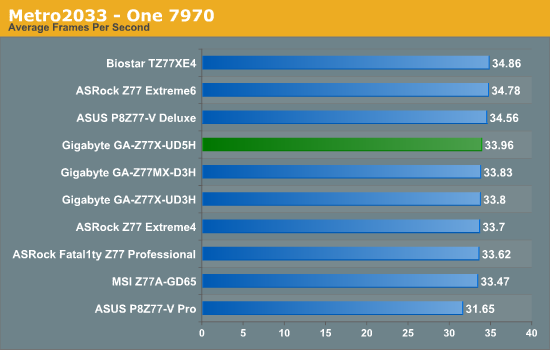
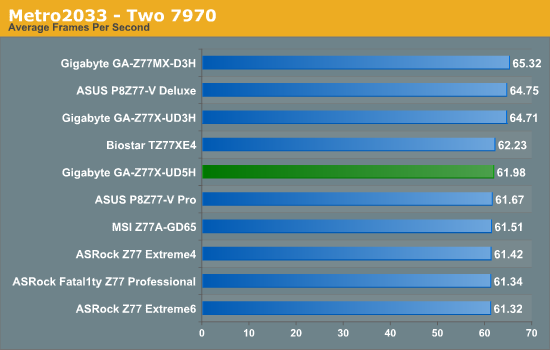
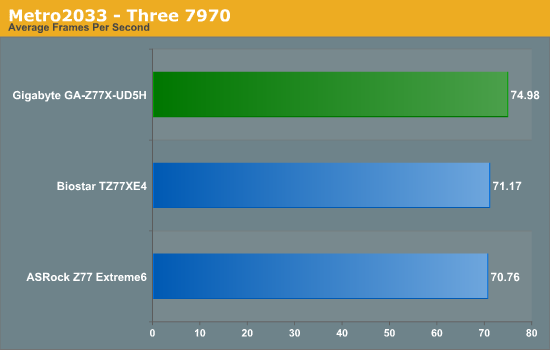
On our Metro 2033 tests, the full PCIe 3.0 functionality of the third GPU shows again, with the Z77X-UD5H performing another 5% better than the Biostar.
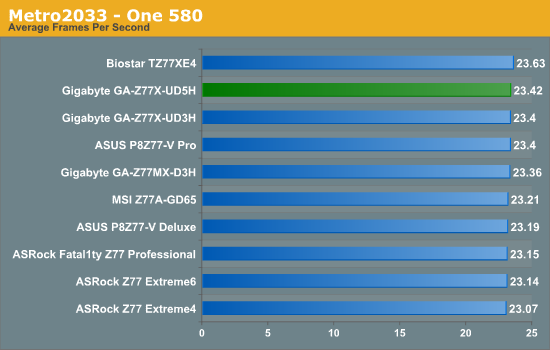
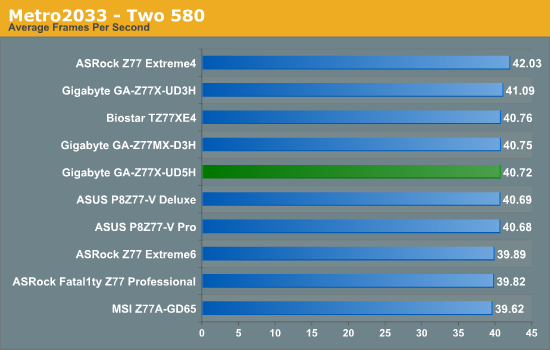
Our NVIDIA testing in Metro 2033 shows every board performing almost the same.










70 Comments
View All Comments
jardows2 - Wednesday, July 25, 2012 - link
Can anyone explain the value in multiple Ethernet ports? Outside of being server board, and some specialized workstations, the practicality (and added cost) of multiple Ethernet ports escapes me.IanCutress - Wednesday, July 25, 2012 - link
Connecting to multiple networks, redundancy, teaming for better throughput, connecting via ICS, VM throughput, one specifically for backups, separation of traffic (i.e. you could have a combo web/database server, same network, put all web traffic on one NIC, db traffic on the other, makes it easier to calculate loads for traffic types). If you're streaming from a NAS that supports teaming, then the improved bandwidth can benefit users that stream from that device. Agreed, it is a perhaps a niche scenario, but there are enough users that want it. The Realtek NIC + Audio is a relatively cheap bundle, but some people prefer the Intel NIC. So why not have both, as long as the price for the user is reasonable.Ian
Snotling - Wednesday, July 25, 2012 - link
If your NAS has two ports... you can team up your nick on both ends.If your two NICs have different chip-sets then it may be for compatibility reasons. Some businesses will want to use only the Broadcom or only the Intel or Marvel... etc. Maybe at some point you can save downtime if a driver update causes a problem either by being bugged or missing.
Load balancing, bridging networks, Acting as gateway or firewall... even if you do not actually run a server on the board you may want to do it for test purposes or some weird networking condition. Like having two different VPNs that require you to be on two different subnets.
I admit, most of this is exceptional conditions but the exceptions addup and higher end boards aim to cover the needs of those who may run into those situations or actually need them.
Grok42 - Wednesday, July 25, 2012 - link
I can't figure it out either. I've built boxes with many nics before for routers, gateways and bridges. Almost all the servers I've built have had 4 nics. However, I can't imagine using the two nics on this board for anything. Why would I want to build a NAS box with SLI and overclocking? Why wouldn't I get a much different board and add a good discrete NIC board with multiple ports? At the consumer level I can't imagine doing any of this. My file server only has a single gigabit nic and is WAY faster that I need. I can move GBs of files in just a few seconds between it and my workstations. At work we have 10GB and we team ports to increase even that so I know there are needs for higher speeds, I just can't figure out a reason at the consumer level this board is obviously focused on.Einy0 - Wednesday, July 25, 2012 - link
I own this board, it is amazing thus far. I haven't really had a chance to really push it too hard yet... One of these weekends I will try some overclocking. The 3770K is so fast, I'm still getting used to it. I am really impressed with the Z77's SATA controllers. My Vertex 4 is topping out at about 562MB/s for reads and my 4 disk (500GB WD Blue) RAID5 Array is hitting around 362MB/s for reads. I would love one more USB 2.0 header or a USB 3.0 to 2.0 header adapter. A non Realtek audio codec would be terrific too...vailr - Wednesday, July 25, 2012 - link
There's evidently 2 board versions of the UD5H:The older version has a space in between the 2nd & 3rd DDR3 slots, with blue capacitors.
The newer version has no space in between the 2nd & 3rd DDR3 slots, with purple capacitors.
Question: why doesn't Gigabyte provide drivers for the VIA USB 3.0 ports? There are some VIA USB 3.0 drivers on www.station-drivers.com, but those fail to install on Windows 7 64-bit.
Sabresiberian - Thursday, July 26, 2012 - link
One of Gigabyte's strengths is that they've long had dual Ethernet capability, but -Why only one Intel? Is it really that much more expensive to just put the best in here?
I think your read of Gigabyte has been right on the money Ian, I've long thought the same, and wondered why some media types blew their horn so loudly.
;)
Zak - Saturday, July 28, 2012 - link
I see no point in adding FireWire any more... I'd rather have two eSATA ports or another SPDIF output. Any why having DVI, DP and VGA? Waste of space. I really doubt anyone has a need for all three simultaneously. If someone needs to use VGA they can use DVI or DP adapter.Zak - Saturday, July 28, 2012 - link
Typo: "Overclocking on the UD5H was a mixed back of results"JimDicks - Saturday, July 28, 2012 - link
This GB mainboard comes with a Marvell 9172 6Gbit/s S-ATA controller, almost same as my GB mainboard. When I recently bought a 6Gbit/s SSD and connected it to the 'superb' Marvell, it only reached about 250MB/s instead of the advertised 600MB/s. A whole afternoon searching and reading forums and specifications revealed that most of these 3rd party chips have a higher latency than the Intel/AMD south bridges, and reach much lower data rate than advertised, because they are connected via 1, maximum 2 PCIe 2.0 lanes to the mainboard. That means that a controller with 4 6.0Gbit/s connectors would need 2.4GB/s to transfer, yet it can only theoretically transfer 0.5GB/s (1 lane) or 1.0GB/s (2 PCIe 2.0 lanes) to the mainboard. In fact, the practical PCIe speed is much less.I recommend that Anandtech not only checks USB speeds, but also S-ATA speeds via the 3rd party chips, the southbridge and via external PCIe x8 SAS Raid Controller (ie. LSI MegaRAID SAS 9240 or 9260). The latter could also be used to check the practical PCIe bandwiths.